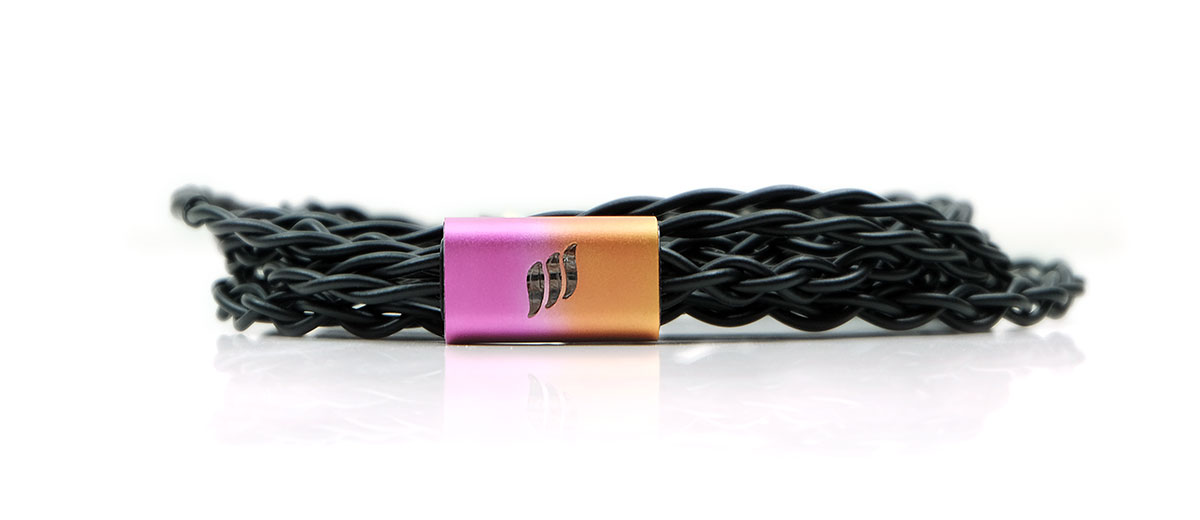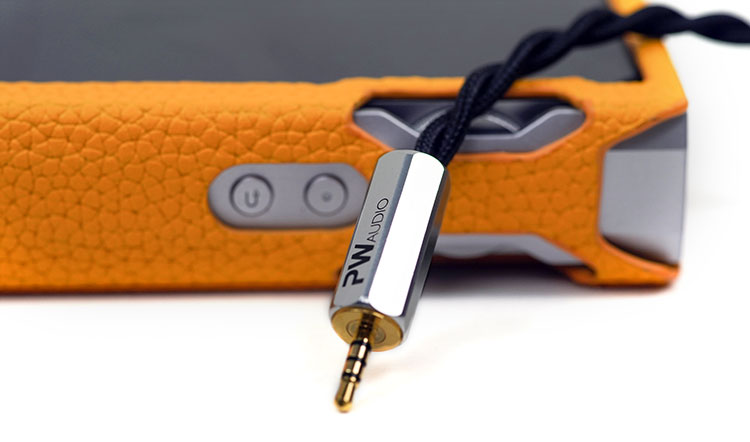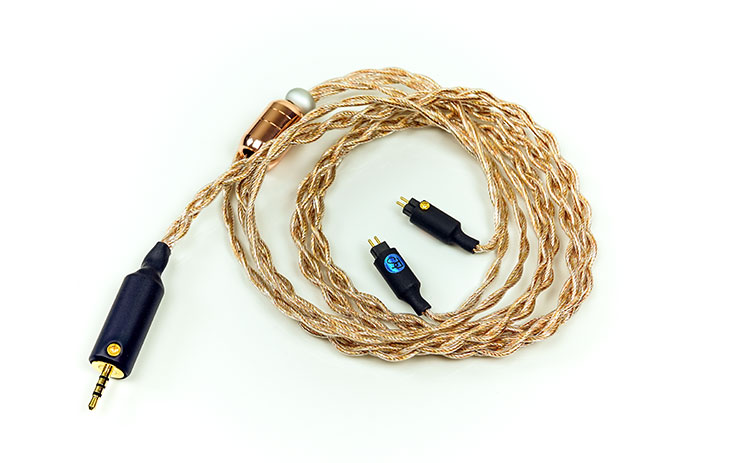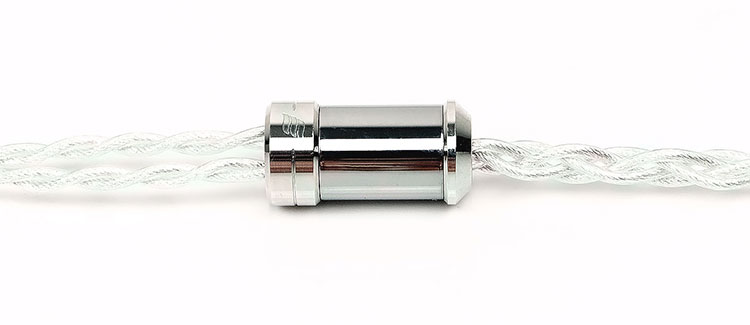EVO 10 Performance Impressions
Summary
With our tested pairings, we found the EVO 10 to offer a relatively high impact and weighted presentation with a slightly smoother midrange and treble response.
Overall, this is a balanced-sounding cable, not as bright or as clean as the PW Audio Monile mids and treble tuning which was our last cable review at a similar price point but also not quite as heavy on the low-end either.
If anything, the EVO 10 accentuates and fleshes out all the listening ‘touch points’ as I like to call them with a ‘meaty’ bass response, broad vocal texture with a forward image, and, if the monitor has it, an articulate but balanced lower-treble.
For those on something like the Cleopatra I do think the low-end has a bit more muscle and the treble is a bit ‘peppier’ but does retain some of that smoothness through the mids that the Cleopatra does so well.
The main difference for me though is the level of low-to-treble contrast seems a bit higher from the EVO 10 compared to the more linear response of the Cleopatra with our tested monitors. In turn, the Cleopatra ups the lower-mids presence a bit more with slightly less vocal focus.
I hesitate a ‘fun sounding’ cable because that can often have connotations of poor resolving capability. Certainly, the level of resolution and dynamic range is excellent but with an additional splash of power and vividness.
This is a synergy that gels particularly well with dynamic driver hybrids such as the Empire Ears Valkyrie MKII or those monitors with U-shaped tuning profiles that have an excellent vocal presence.
Timbre
With a mix of pure copper and SPC, you always get a lot of familiar traits from both materials. The timbral response of the EVO 10 is broadly on the smooth and natural side rather than clean or neutral.
There is a slight bias to flesh out lower-order harmonics so the low-end of the tested monitors came across as rich and full sounding, especially with dynamic driver timbre which just comes alive spectacularly with the EVO 10.
In contrast, the top-end has some energy but not a spikey clean sound rather just a peppy well balanced treble response. The clarity and headroom are excellent but it lacks any sharpness at the same time. Again, I say this in context to the PW Audio Monile which sounded a bit cleaner and brighter up top.
The EVO 10 pairing did tease out a gorgeous mids timbre though with a stronger vocal focus and an excellent body to go with it. The harmonic balance here has a slight bias to warmth but nothing as sustained as something like the PLUSSOUND Tri-Copper which sounds more rounded to me with less upper-order harmonics creeping in.
I thought the timbral synergy was excellent with the likes of the Andromeda 2020 which is not as bright as the original version. It teases out some lovely treble detail and a strong vocal presence but still keeping it very much to the natural side of things.
Staging
On our tested monitors, the dynamic range is very good with the EVO 10 pairing with a strong sense of space through the mids, perhaps more so than one or two of our compared cables.
The depth is indeed excellent, even with BA monitors you get a lovely perception of power and slam but neither does it push it to the max which I appreciate for the way it allows the mids to breathe.
Vocals come out very well with the EVO 10 staging with plenty of air to breathe and a little more forwardness and focus than I expected. Imaging cues, especially, from the mids upwards sound more solid and smooth than bright and crisp.
One slight difference I did find with something like the Cleopatra is the comparative stretch in the mids. The EVO 10 has less of a linear staging quality compared to the pure silver of the Cleopatra which does a marvelous job of presenting the mids as a ‘whole’.
The EVO 10 does not quite push the lower-mids forward as much as the vocals and percussion on the likes of the Andromeda 2020. I suspect that is due to the weightier bass catching your ear faster whereas the Cleopatra pulls back on the bass just a little in comparison to let the lower-mids presence shine a bit more.
Synergy
The EVO 10 is quite a flexible cable pairing for most monitors we tested it with. I think this is going to come down to just how you like your presentation more than a specifically bad match. The cable seems built for excitement, impact, and some clear focus on a good low-end, smooth forward vocals and balanced but not overly bright treble.
My only caveat is if you like brighter treble or a very clean neutral sound then the EVO 10 synergy might not be what you are looking for. Otherwise, it plays very well indeed with the likes of the Lime Ears Pneuma, Campfire Audio Andromeda 2020, and the Empire Ears Valkyrie MKII.
If I was being a stickler I would say the synergy was less compelling if the monitor is already a rich and overly warm stock sound or if the bass is very lean and neutral. The EVO 10 is unlikely to add an abundance of clarity in that warmth or radically change that lean bass.
Monitors such as the Gae Bolg might be better with a brighter cleaner cable such as the PW Audio Monile, whereas higher contrast offerings with a great bass response such as the Empire Ears Valkyrie MKII were perfect for the vivid sound of the EVO 10.
In fact, this is where I found the best pairings, those monitors that are tuned for impact on the low-end and good energy on the top-end. The EVO 10 was able to enhance that sense of a strong PRaT without going overboard, keeping the vocal timbre broad and smooth whilst never really thinning out any energetic treble.
Select Comparisons
PW Audio Monile
$551.99
Technical
The PW Audio Monile was reviewed by us in late December and our second PW Audio review though we do have a few more in our office for personal use. Both are 4-core cables, however, the Monile also uses a mix of two different copper and silver wire elements but with different gauges and geometries.
The Monile uses a mix of both gauge and wires with a 26AWG ultra-purity copper and 25.5AWG super-purity silver 4-core compared to the EVO 10 which has all 4 wires at 26AWG and using a mix of UP-OCC Gold-Plated Copper and UP-OCC Silver-Plated Copper.
As far as I am aware the Monile is not a Litz geometry compared to the 7 bundle Litz design of the EVO 10. Instead, the Monile uses a positive and negative conductor geometry for its 4-core build with 2 positive conductors and 2 negative conductors as the cable’s shielding.
Design
Both have an outwardly black appearance but with some big differences. The Monile uses a nylon jacket compared to the EVO 10 UltraFlexi PVC variant so they feel quite different in the hand with the Monile offering a softer quality to the touch.
Both have tight braiding though the Monile forgoes a braiding design above its splitter whereas the EVO 10 continues on a 2-wire braid post-splitter. Weight-wise there is not a huge difference between either of them and both have very little memory retention when unfolded. Microphonics are similar levels for both cables which means quite low.
Termination options are also quite similar with both able to offer the big 3 of 3.5mm, 2.5mm and 4.4mm depending on your preference. One key difference with the EVO 10 is the ability to use ConX interchangeable connectors for an additional $50 whereas with the Monile you only get one choice. That might be a big factor for interested buyers.
The other big difference is the finishing with the EVO 10 using the new square-frame connectors (stock not ConX), as well as the replaceable splitter covers whereas the Monile uses a fixed hexagonal aluminum splitter and jack.
Performance
I tested these two cables with the Empire Ears Valkyrie MKII and the 64 Audio tia Trio. There is not a huge amount of difference between these two cables, rather it is more nuanced than dramatic.
Both cables do an excellent job in terms of dynamic range maximizing the response and clarity of the low-end, however, the Monile returns a slightly more weighted response compared to the EVO 10 and a cleaner mids to treble overtone.
The EVO 10 seems a little more balanced across the range with a slightly warmer more natural timbre and smoother treble tone. Certainly, on the Valkyrie MKII, the Monile sub-bass presence was a little more prominent whereas the EVO 10 was a shade softer with more mid-bass warmth creeping through.
Both hit heavy, no diminution from either cable in terms of power, but the overall feel was the low-end of the Monile dominated whereas the EVO 10 left a bit more space for the mids. As a result, the mids of both IEMs are cleaner in tone, or cooler in timbre, on the Monile, but not quite as vivid and meaty as when paired with the EVO 10.
For me, the EVO 10 gave both monitors a smoother fuller-sounding vocal and percussion tone whereas the Monile opts for a bit more sparkle and treble energy with slightly less vocal weight.
Plussound Tri-Copper
$549
Technical
Despite being launched a few years ago in 2018, the Plussound Tri-Copper is still a very solid option and has gone through some materials improvement since we reviewed it also. Both the Tri-Copper and the EVO 10 are 26AWG 4-wire builds and the materials are quite similar to a point with the geometry and designs showing significant variation.
The Tri-Copper logically uses three different types of copper, UP-OCC copper, silver-plated copper, and gold-plated copper all in a single wire. The EVO 10 actually uses 2 out of the three materials inside the Tri-copper with UP-OCC Gold-Plated Copper and UP-OCC Silver-Plated Copper in a single mixed wire, (non-alloy).
EA has opted for a proprietary Litz creation for their geometry with a 7-core bundle with no fiber core whereas the Tri-Copper follows a more standard Type 6 Litz design featuring bundles of type-4 wire twisted around a fiber core.
Design
Note, the picture above is an older version of the PLUSSOUND finishing which is not as tidy as what they offer now.
The Tri-Copper has more of a classic PVC transparent jacket style jacket finish with a strong coppery hue whereas the EVO 10 uses the new all-black UltraFlexi PVC finish so very different lookers.
The EVO 10 is a little heavier than the sample we have here but I suspect more due to the additional ConX and memory wrap whereas the Tri-Copper uses non-interchangeable connectors and no memory wrap.
Both have the exact same disciplined and tight braiding design with a short overthrow, no memory retention, and very easy handling. If I am being ultra-fussy I would say the new jacket on the EVO 10 is just marginally more rigid but that’s very marginal. The lack of memory wire on the Tri-Copper does give it the edge for friction microphonics around the ear.
PLUSSOUND uses their excellent screw-lock connectors with matching barrels in black whereas the EVO 10 uses the new square-frame connectors and barrel. I have always admired the PLUSSOUND finishing but this time I think EA has closed the gap with those additional E-Face plates a nice touch.
Certainly, the introduction of ConX provides a more versatile system than what the Tri-Copper can currently offer. However, with both cables in stock format, you get similar connector and jack options such as 2-pin/MMCX, 3.5mm, 2.5mm, and 4.4mm.
Performance
The Tri-Copper is a lot more rounded in the mids and slightly warmer sounding overall compared to the EVO 10 using the Valkyrie II and the tia Trio.
What I mean by rounded is a diminution of treble presence in the Tri-Copper presentation that dampens mids upper-order harmonic accuracy and inflating lower-order harmonics in the instrumental and vocal timbre.
With the EVO 10, you get more treble presence and energy so it combined a natural tone with a bit more crispness in vocals and percussion. It still sounds natural and smoother than the neutral Monile mids and treble but definitely more accurate compared to the rich broad and liquid sound of the Tri-Copper pairing.
The low-end of the Tri-Copper pairings also teased out more bloom and warmth pulling my ears further down to the lower-mids and bass response. Here depth is king with the Tri-Copper weight sounding planted, full and rich.
The EVO 10 is not as bloomy or rich and sounds tighter on the low-end opening allowing the mids to breathe a bit better. With both monitors, I had a better perception of height and sparkle with the EVO 10 creating a more balanced staging effect.
Effect Audio Effect Audio Cleopatra
$699
Technical
The Cleopatra was launched in early 2019 and is part of their separate Heritage series of cables with a slightly higher price point of $699. Both it and the EVO 10 are 4-wire 26AWG cables though you can get the Cleopatra in an 8-wire version called the Cleopatra Octa.
The Cleopatra has, on paper, a much simpler wire mix with a single 4-wire high purity UP-OCC Pure Silver compared to the UP-OCC Gold-Plated Copper and UP-OCC Silver-Plated Copper of the EVO 10.
Both do have a 7-core Litz geometry with individually enameled strands but with some differences. The Cleopatra uses a multi-sized stranding composition whereas the EVO 10 does not and it also includes EA’s golden ratio for the layering of the wires within the Litz build.
Design
Massively different designs with Cleopatra’s bright shimmery silvery and chrome aesthetic behind a transparent UltraFlexi PVC jacket compared to the monotone black alternative UltraFlexi PVC jacket on the EVO 10.
In many ways, the Cleopatra design is where EA was 2 years ago so it has the hallmarks of the designs from then. That means the silvery allow round splitter, carbon fiber, and silver alloy jack barrel, as well as the small silver connector tubes.
The EVO 10 is a completely different beast in that regard with its square-frame connectors and jack barrel, interchangeable E-face splitter plates, and transparent splitter.
Both cables handle relatively similarly with regard to low memory retention and similar braiding technique. It could well be the coloring deceiving my mind but the Cleopatra jacket feels ever so slightly softer than the EVO 10 alternative.
There is far less memory wire on the EVO 10 compared to the Cleopatra so the EVO 10 feels the heavier of that two around that area. Both can come finished with ConX but without it, the Cleopatra connectors are lighter.
Performance
On the tia Trio and Valkyrie MKII, the Cleopatra pairing sounds a shade more linear and balanced compared to the more excitable EVO 10.
I have remarked in my previous Cleo review just how well the low-end extends with this cable pairing and it still does to my ear. It is not your typical pure silver sound. However, the EVO 10 produces a bit more body and warmth with bass synths sounding more prominent and ‘phatter’. The Cleopatra just takes a shade of that ‘bounce’ off with a more controlled response.
In turn, the mids are a bit more prominent across the range with the two monitors using the Cleopatra, and this also translates into a smoother transition into the treble. That means a very coherent singular timbre right across the range but not a huge amount of comparative treble sparkle.
The EVO 10 has that trademark SPC energy coming into the Valkyrie II upper mids and lower-treble so it tips from warm with weight on the low-end to slightly cleaner and ‘spicier’ up top.
Vocals actually sound a bit further forward with the Valkyrie MKII/EVO 10 pairing but the Cleopatra gives me a bit more detail and balance through the entire midrange.
I feel I am getting more lower-mids information and the ‘bigger picture’ with the Cleo pairing whereas the EVO 10 emphasizes the dynamic parts, the fun parts, namely bass, percussion, and vocals.
Our Verdict
The Effect Audio EVO 10 is a peppy, high-impact cable that pairs really well with dynamic-sounding monitors or those with good vocal presence. It has enough of a nuanced mix of weight, mids range smoothness, and a natural treble timbre to pair really well with a wide range of monitors, however. It is exciting sounding but not fatiguing either.
I think a lot of people will also be attracted to the more complex design and darker finish of this cable. It handles beautifully as all EA cables generally do. This time, however, it just looks so modern, urban in a way with its stealthy black ambiance and those interchange splitter E-Face accents.
If you can get ConX then do so because if you have more than one monitor with different connectors the $50 premium is well worth it to allow you to be able to connect without adapters. This is a very clean low-profile solution and perfect for the EVO 10 given how well it synergizes with so many different monitors.
Effect Audio EVO 10 Specifications
- Wire Gauge: 26AWG
- Wire Material: UP-OCC Gold-Plated Copper & UP-OCC Silver-Plated Copper
- Wire Type: Septupled core bundled Litz with Surlyn insulation
- Jacket: EA UltraFlexi™ insulation
- Length: 1.2m







